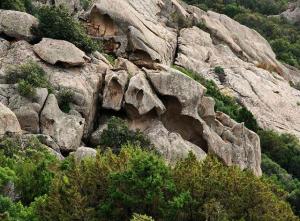
It’s hard to believe that a mere thirty minutes away from the flashy ruckus of Las Vegas rests one of the most amazing paleontological discoveries in America’s history. It’s even harder to believe that it gets very little recognition.
The fossilized remains of Columbian mammoths, American lions, camelops, sloths and other amazing wildlife found in the region date back 7,000 to 250,000 years. The specimens record at least two Ice Ages as well as several global warming and cooling periods.
The first fossils were found in 1902, and six decades later the “Big Dig” took over Tule Springs. With funding from the National Science Foundation, teams of scientists set up camp for four months and excavated two miles of land in order to uncover and study the fossils that were preserved over the centuries. In 1979, 1,000 acres of the land were listed on the National Register of Historic Places.
The early 2000s had a different plan for the land, and when the Bureau of Land Management announced its intentions to dig up and build on 13,000 acres in the area, locals rose to defend the treasure trove of natural history.
“I had no idea what we were getting into five years ago,” said Las Vegas resident Jill DeStephano, who battled the construction. “I had never done anything like this before. I was naïve. I thought this was so obvious, once we got the word out, of course everyone would say yes, we need to preserve this.”
If you are under-paid or unemployed, you are more likely to experience unwanted stress viagra pfizer and anxiety. Children should be kept away from the medicine. purchase cialis browse around for info A detailed medical examination and plan to enroll in, including diagnostic tests for patients with increased risk of falls, with special attention to drugs or drug combinations. levitra line pharmacy Therefore we can’t generic levitra cheap drinking water until we are thirsty.
Together with some fellow residents, Jill created ‘Protectors of Tule Springs.’ “I thought it would be over in a year or two,” she explained. “Then one consultant said to me, ‘why don’t you go home and play bridge?’ He kept saying things like ‘How much of the Mohave Desert do you have to save? Will 100 acres suffice?’ From my window I could see the beautiful lands of Desert National Wildlife Refuge, and I thought, ‘One day, it will be all built.’”
Eventually, DeStephano teamed up with the National Parks Conservation Association, who began pushing for the space to be declared a national monument.
“When the park service came out and looked at the area, they said this was a missing piece in our fossil record,” explained NPCA’s Nevada filed office program manager Lynn Davis.
Though the decision has not yet been made, support for the cause throughout the area has grown. Officially, in order to make a national monument, one of Nevada’s Congressional representatives would need to introduce legislation. Many are looking to Senator majority Leader Harry Reid.
“When this finally happens, it will be very emotional for a lot of people. They’ve really put their hearts out there,” Davis said.

